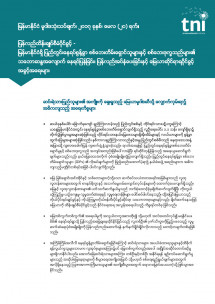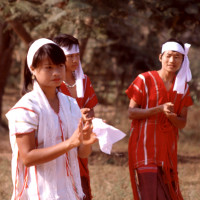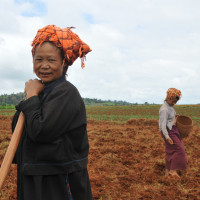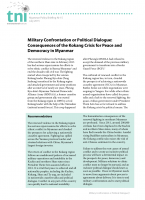ျပန္လည္ထိန္းခ်ဳပ္စီမံပိုင္ခြင့္ - ျမန္မာႏိုင္ငံရွိ ျပည္တြင္းေနရပ္စြန္႔ခြာ စစ္ေဘးတိမ္းေရွာင္သူမ်ားႏွင့္ စစ္ေဘးဒုကၡသည္မ်ား၏ သေဘာဆႏၵအေလ်ာက္ ေနရပ္ျပန္ျခင္း၊ ျပန္လည္အပ္ႏွံေပးျခင္းႏွင့္ ေျမယာဆိုင္ရာရပိုင္ခြင့္ အခြင့္အေရးမ်ား
Topics
- Land Policy in Myanmar
- Ethnic Conflict in Myanmar
Regions
Publication date:

ဆင္းရဲသားျပည္သူမ်ား၏ အက်ိဳးကို ေရွးရႈသည့္ ေျမယာမူ၀ါဒဆီသို႔ ေလွ်ာက္လွမ္းရာ၌ အဓိကက်သည့္ အေရးကိစၥမ်ား
- ဆယ္စုႏွစ္ေပါင္း ေျခာက္ခုေက်ာ္ ရွည္ၾကာလာခဲ့သည့္ ျပည္တြင္းစစ္ႏွင့္ တိုင္းရင္းသားပဋိပကၡေၾကာင ယေန႔ျမန္မာႏိုင္ငံအတြင္း ေနရပ္စြန္႔ခြာစစ္ေဘးတိမ္းေရွာင္လ်က္ရွိသည့္ လူဦးေရေပါင္း ၁.၁ သန္း ေက်ာ္ရွိရာ၌ တိုက္ပြဲျဖစ္ပြားမႈအမ်ားဆံုးျဖစ္သည့္ တိုင္းရင္းသားနယ္ေျမေဒသမ်ားရွိအိုးအိမ္မ်ားႏွင့္ လယ္ယာမ်ားကို စြန္႔ခြာ ထြက္ေျပးမႈအမ်ားဆံုးျဖစ္သည္။ ႏွစ္ကာလရွည္ၾကာလာသည္ႏွင့္အမွ် ျပည္တြင္းစစ္မီးသည္ ေနရာေဒသအႏ အျပားသို႔ လူးလားေခါက္ျပန္ ကူးစက္ပ်ံ႕ႏွံ႔သြားခဲ့သည္။ ရလဒ္အေနျဖင့္ ျပည္တြင္းေနရပ္စြန္႔ခြာစစ္ေဘးတိမ္း ေရွာင္မႈႏွင့္ စစ္ေဘးဒုကၡသည္ အက်ပ္အတည္းျဖစ္ေပၚလာခဲ့ၿပီး ရင္ဆိုင္တုန္႔ျပန္သည့္ အေရးယူေဆာင္ရြက ခ်က္မ်ားသည္လည္း နယ္ေျမေဒသအလိုက္ ပံုစံအမ်ိဳးမ်ိဳးကြဲျပားလ်က္ရွိသည္။ ျပည္တြင္းေနရပ္စြန္႔ခြာ စစ္ေဘး တိမ္းေရွာင္သူမ်ား (IDPs) ၏ လိုအပ္ခ်က္မ်ားကို ျဖည့္ဆည္းေထာက္ပံ့ရာ၌ နယ္ခံအဖြဲ႕အစည္းမ်ားက အဓိက က်သည့္မ႑ိဳင္တစ္ရပ္အျဖစ္ ပါ၀င္လ်က္ရွိသည္။
- ေျမ၊ ျမစ္ေခ်ာင္းအင္းအိုင္ႏွင့္ သစ္ေတာမ်ားကဲ့သို႔ေသာ ဆက္စပ္သယံဇာတအရင္းအျမစ္မ်ားသည္ လူထ လူတန္းစားမ်ားအတြက္ စားနပ္ရိကၡာႏွင့္ အသက္ေမြး၀မ္းေက်ာင္းလုပ္ငန္းမ်ားကို ေထာက္ပံ့ေပးလ်က္ရွိသည္။ ေျမႏွင့္ လူထုလူတန္းစားမ်ား၏ ပတ္သက္ဆက္ႏြယ္မႈသည္ ဘက္စံုေထာင့္စံုမွခ်ိတ္ဆက္လ်က္ရွိၿပီး ကိုးကြယ ယံ ၾ ု ကည္မ ၊ ႈ ယဥ္ေက်းမႈ၊ လူမ ဆ က္ဆ ေ ရးႏွင ့ ္ လူမ ေ ရးတန္ဖ း ု ိ မ်ား ေပါင္းစပ္ပါ၀င္ေနသည္။ ထိ အ ု ျပင္ေျမယာသည ကိုယ္ပိုင္အုပ္ခ်ဳပ္ခြင့္ႏွင့္ ကိုယ့္ၾကမၼာကိုယ္ဖန္တီးပိုင္ခြင့္ဆိုင္ရာ သေဘာတရားမ်ားႏွင့္လည္း ခ်ိတ္ဆက္ေနသျဖင ေျမယာကို ထိန္းခ်ဳပ္စီမံပိုင္ခြင့္သည္ ႏိုင္ငံေရးအရ အလြန္အေရးပါသည့္ ကိစၥရပ္တစ္ခု ျဖစ္သည္။
- ေျမတစ္ကြက္တစ္ကြက္၏ အေရးပါမႈကို အလြယ္တကူအစားထိုး၍ သို႔မဟုတ္ အလဲအထပ္လုပ္၍ မရႏိုင္ေပ။ မိမိ၏ ေနရင္းရပ္ရြာသို႔ ျပန္လည္အေျခခ်ေနထိုင္ႏိုင္ျခင္းသည္ လူတစ္ဦး၏ ဂုဏ္သိကၡာကိုျပည့္၀ေစသည့္ လူမ ဆက္ဆံေရးပံုစံအမ်ိဳးမ်ိဳးကို ျပန္လည္တည္ေဆာက္ရန္ နက္နက္ရိႈင္းရိႈင္းလိုလားသည့္ ေတာင့္တခ်က္တစ္ခုျဖစ သည္။
- အႀကိမ္ႀကိမ္အလီလီ ေနရပ္စြန္႔ခြာတိမ္းေရွာင္ရျခင္းေၾကာင့္ ဆင္းရဲသားမ်ား၊ အပယ္ခံထားရသူမ်ားႏွင့္ထိခိုက ရန္လြယ္ကူသူမ်ားသာမက လူအုပ္စုမ်ားအၾကား၌ပင္ ေျမတစ္ကြက္တည္းအေပၚ အၿပိဳင္အဆိုင္ေတာင္းဆိုမ မ်ားရွိလာႏိုင္ပါသည္။ ေအာက္ေျခဆင္းရဲသားမ်ားအၾကား တစ္ဦးႏွင့္တစ္ဦး အႏိုင္ရရန္ ခ်ဥ္းကပ္ေဆာင္ရြက္မ မ်ားသည္ အဆိုပါေျမေနရာမ်ားကို စီးပြားေရးအက်ိဳးအျမတ္ သို႔မဟုတ္ စစ္ေရးရည္ရြယ္ခ်က္မ်ားအတြက အလိုရွိေနသည့္ ၾသဇာအာဏာႀကီးမားသူမ်ား၏ အက်ိဳးစီးပြားအတြက္ ေရလာေျမာင္းေပးသကဲ့သို႔ ျဖစ္သြားေစ ႏိုင္သည္။
- ရပိုင္ခြင့္အခြင့္အေရးမ်ားကို ျပန္လည္အပ္ႏွံရာ၌ အသိအမွတ္ျပဳျခင္းႏွင့္ ေျမယာျပန္လည္ခြဲေ၀ေပးျခင္းတ ပါ၀င္ရန္ မျဖစ္မေနလိုအပ္သည္။ ႏိုင္ငံေရးမဟာဗ်ဴဟာမ်ားသည္ ‘ဆင္းရဲသားအခ်င္းခ်င္း’ ေဆြးေႏြးတိုင္ပင္၍ အမ်ားဆံုးထိခိုက္နစ္နာခဲ့ရသူမ်ားအား ဂုဏ္သိကၡာရွိရွိ အတူတကြယွဥ္တြဲေနထိုင္ႏိုင္ေစမည့္ ေျဖရွင္းေရး နည္းလမ္းမ်ားကို အားလံုး၏ပူးေပါင္းပါ၀င္မႈျဖင့္ အဖက္ဖက္မွ စဥ္းစားတြက္ခ်က္၍ ေဆြးေႏြးအေျဖရွာရန ေအာက္ေျခလူထုလူတန္းစားမ်ား လိုအပ္သည့္အခ်ိန္ႏွင့္ ႏိုင္ငံေရးအခင္းအက်င္းမ်ိဳးကို စနစ္တက် ျပင္ဆင္ေပး ရန္လိုအပ္သည္။
- ေျဖရွင္းေရးနည္းလမ္းမ်ား၌ အလြန္အေရးပါသည့္ အခ်ဳိ႕ေသာအဂၤါရပ္မ်ား မျဖစ္မေနပါ၀င္မႈရွိရန္ လိုအပ္သည္။ ယင္းတို႔၌ လူတစ္ဦးခ်င္းစီ အသက္ေမြး၀မ္းေက်ာင္းျပဳရန္ လံုေလာက္သည့္ အနိမ့္ဆံုး ‘ၾကမ္းခင္းပမာဏ’ သာမက အသံုးျပဳသူ သို႔မဟုတ္ ပိုင္ရွင္တစ္ဦးအတြက္ အမ်ားဆံုးခြင့္ျပဳေပးႏိုင္သည့္ ‘အျမင့္ဆံုးပမာဏ’ ကိုပါ သတ္မွတ္၍ လူတစ္ဦးခ်င္းစီ ေနထိုင္လုပ္ကိုင္စားေသာက္ႏိုင္သည့္ ေျမယာပမာဏကို အာမခံေပးျခင္းတို႔ပါ၀င္သည္။ ေက်းရြာအတြင္း တိုးပြားလာမည့္ ေနာင္အနာဂတ္မိသားစုသစ္မ်ားအတြက္ အရန္ေျမမ်ားသတ္မွတ္ထားရွိျခင္း ႏွင့္ေက်းရြာ သို႔မဟုတ္ ေက်းရြာပိုင္ေျမမ်ားကို ျပင္ပသို႔ ေရာင္းခ်မႈကို ကန္႔သတ္ပိတ္ပင္မႈမ်ားအပါအ၀င ေျမယာထိန္းခ်ဳပ္စီမံမႈႏွင့္ ပတ္သက္သည့္ ရပ္ရြာဓေလ့ထံုးတမ္းအေလ့အထမ်ားကို အသိအမွတ္ျပဳ၍ အားေပး အားေျမႇာက္ျပဳရန္ အလြန္အေရးႀကီးသည္။
- မူ၀ါဒမ်ားသည္ တစ္ပိုင္တစ္ႏိုင္စိုက္ပ်ိဳးေရးလုပ္ငန္းကို အားေပးအားေျမႇာက္ျပဳသင့္ၿပီး ေျမယာျပန္လည္ခြဲေ၀ ေပးျခင္းႏွင့္ အသိအမွတ္ျပဳ၍ ျပန္လည္အပ္ႏွံေပးသည့္ မူ၀ါဒမ်ားသည္ သက္ဆိုင္ရာေျမေပၚလုပ္ကိုင္စား ေသာက္လ်က္ရွိသည့္ ဆင္းရဲသားမ်ားကို အက်ိဳးျပဳရန္လိုအပ္သည္။ ခ်ဥ္းကပ္ေဆာင္ရြက္သည့္နည္းလမ္း မ်ားသည္ တိုင္းရင္းသားအေရးကို အထူးတလည္အေလးထားရန္ လိုအပ္ၿပီး ေျမယာထိန္းခ်ဳပ္စီမံမႈႏွင စပ္လ်ဥ္း၍ မတူကြဲျပားသည့္ တိုင္းရင္းသားမ်ိဳးႏြယ္စုအသီးသီး၏ သက္ဆိုင္ရာအခြင့္အေရးမ်ားက အသိအမွတ္ျပဳ အကာအကြယ္ေပး၍ တိုင္းရင္းသားမ်ိဳးႏြယ္စုမ်ားအၾကား ျဖစ္ေပၚလာသည့္ တင္းမာမႈမ်ားက လူမႈေရးတရားမွ်တမႈရႈေထာင့္မွ ကိုင္တြယ္ေျဖရွင္းေပးႏိုင္ရမည္။ ထို႔အျပင္ အမ်ိဳးသမီး-အမ်ိဳးသားေရးရာႏွင ေဂဟေဗဒစနစ္အရ ေရရွည္တည္တံ့ခိုင္ၿမဲမႈကိုပါ အေလးထားစဥ္းစားရန္လိုအပ္သည္။
စိတ္ကူးမွသည္ လက္ေတြ႕ဆီသို႕


